Egg Rockets - Silliness and Celebrations: Doing Fun Science at Home during School Closures (Activity #10)
Follow along with a Science Buddies parent who is using family STEM activities to keep her kids learning at home during the COVID-19 school shutdown. New posts every Monday, Wednesday, and Friday. Today's adventure... launching rockets made out of plastic Easter eggs.
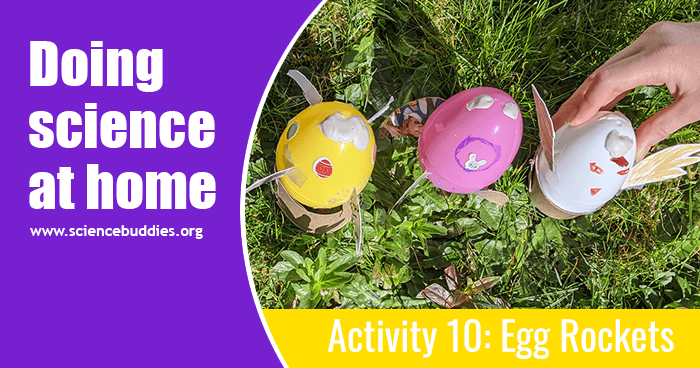
Embracing Silliness, Themes, and Celebrations
I find myself forgetting what day it is more and more. I'm used to keeping track of the day by the hustle of our family-life schedule. Monday is my turn to drive carpool, every other Tuesday is scouts, then there's after school drama class, book club, movie night, a PTO meeting, etc. With all that gone, it's easy to lose track of time and skip over the spring themes and celebrations — but if we do, we also lose some of the fun.
Spring and Easter, specifically the secular version with bunnies, candy, and eggs, provide a great backdrop for family science. The resulting activities can be a bit silly, like using Peeps as a stand-in for other items in some of the experiments. But to me, that's a bonus. We could all use more light-hearted fun right now!
Here are a few options for activities that are fun any time but can be specifically re-themed for spring or Easter:
- Circus-Trick Science: How to Balance Anything: substitute the marshmallows in this activity for Peeps, and it becomes quite comical. How big a structure can you balance?
- Dye Eggs Using Silk Ties for Egg-cellent Colors: if you happen upon a stash of unwanted silk ties in the long-forgotten section of a closet, you can try this strange and beautiful egg-dyeing method. Which tie makes the coolest egg design?
- Candy Rainbow: jelly beans and other Easter basket goodies are great to try in this rainbow-making activity. Which candy types and colors create the best effects?
- Build a Rubber Band-Powered Car: chocolate bunnies and toy chicks make excellent passengers. How many can your car carry?
- Launching Homemade Baking Soda Rockets: turn a plastic Easter egg into a rocket. How high can it fly?
My Pick of the Day: Plastic Easter Egg Rockets
We molded hard-boiled eggs into fun shapes last week, but today, we pulled out our stash of plastic eggs for an Easter-twist on baking soda and vinegar rockets.
Combining baking soda and vinegar is one of those classic chemistry experiments to play with. Kids, including my own, love to watch the fizzing and bubbling that occurs as the two ingredients react to make water and carbon dioxide. We've experimented with that combo in my house many, many (seriously... dozens) of times, but we've never done the Launching Homemade Baking Soda Rockets activity — probably because we don't have any film canisters. My co-worker, Amy, mentioned that she'd seen someone use plastic Easter eggs as a variation, and I thought that was worth a try and that my kids would get a kick out of watching the colorful eggs pop open and the top half fly off.
This activity actually took a surprising amount of fiddling with — but in the end we got a system that worked, and both of my kids enjoyed the journey and were quite proud of our group problem solving.
As with some of our other projects, like kite making, it started off with some building and decorating. We used cereal boxes and other pieces of cardboard (I've been raiding our recycling bin regularly for science activity supplies) to make decorative elements like wings and fins that we taped onto our egg rockets. We also crafted simple cardboard ring stands to place the egg rockets in, so they would stand upright for launch.
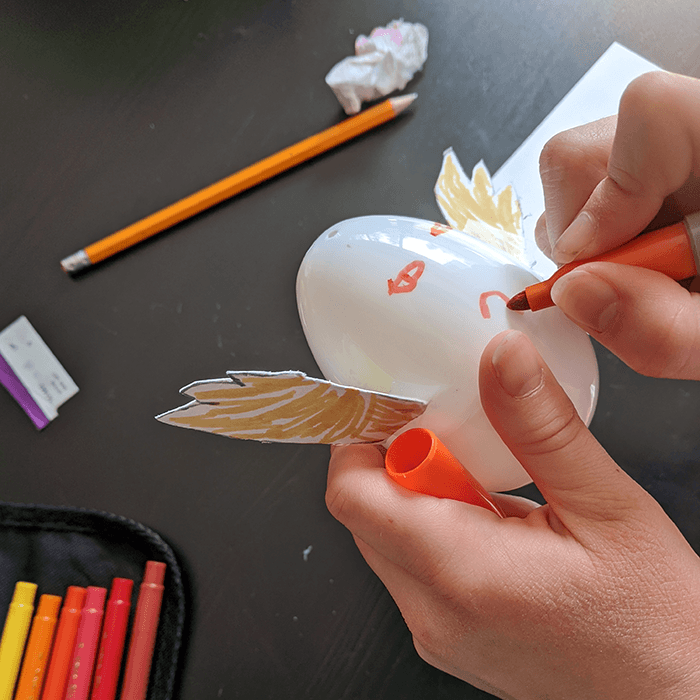
Once the egg rockets were decorated, it was time to figure out how to load them with the vinegar and baking soda. The science idea behind this activity is that in a closed container, like the plastic Easter egg or a film canister, the baking soda and vinegar will react and generate carbon dioxide gas that will build up and create enough pressure to eventually launch the top half of the container into the sky. Film canisters work really well for making this kind of rocket because they can be snapped closed quickly and have very tight seals, so the carbon dioxide doesn't leak out. In contrast, our plastic eggs had a couple of design flaws I knew we'd need to overcome for this activity to work.
The first problem was easy: there were holes (maybe from the molding process?) in the tops and bottoms. Solution: we plugged them with polymer clay. (It worked, and, in some places, it looked like hair!) I think a glue gun would have worked, too.
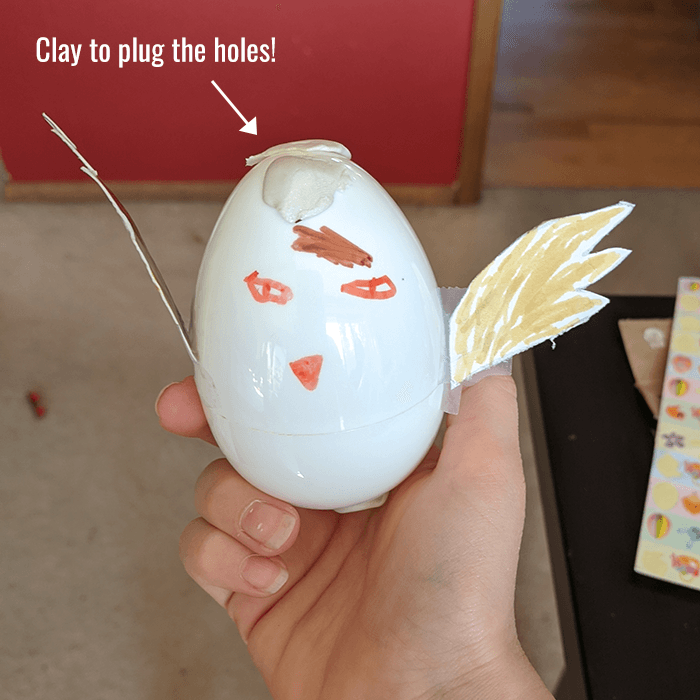
The other problem was more complicated and took quite a bit of trial and error — but hey, that's part of science! It's certainly part of what my team does when we develop new activities for Science Buddies. In short, we found that securely closing our flimsy plastic Easter eggs took too long compared to the speed of the baking soda and vinegar reaction. We either ended up holding a half-open fizzing mess or having the egg pop open in our hands.
It wasn't working at first, but the kids didn't mind — it was all messy fun.
We discussed all sorts of ways to slow the reaction down. My middle-school son came up with the idea of making a shelf for the baking soda and then closing the egg and shaking to get the baking soda to fall into the vinegar. While this didn't quite work, it was the basis for our final solution. This is what we found worked (for our plastic Easter eggs at least) in the end:
- We made tablets of baking soda by mixing in a tiny bit of water and then pressing the slightly damp powder hard into a half-teaspoon mold. This meant less surface area contacting the vinegar all at once, thus slowing the reaction.
- The reaction was still too fast though, so we also put the baking soda tablets into little homemade paper pouches. We put a paper pouch holding a tablet in the top half of the egg, filled the bottom half with vinegar, snapped it closed, shook, set the egg in the cardboard holder, and then stepped back and waited for the launch.
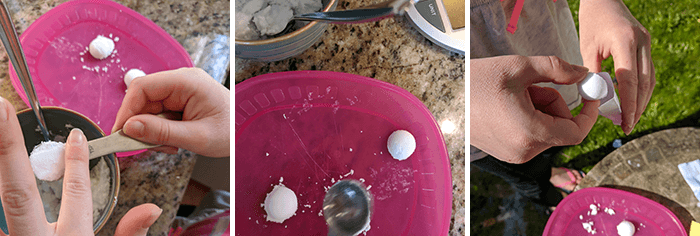
In the end, we achieved flight about two-thirds of the time using our final solution. It took about a minute for each egg to launch, and we saw the flight height range from one to four feet. I found it necessary to remind the kids often to step back so as not to accidentally have an egg launch in their face.
Overall, I'd call this a really successful activity. Not because it worked easily — it didn't. It was successful because the kids were excited and engaged during the whole troubleshooting experience (unlike the robot hand, which was too much for my second-grader).
If you're trying this at your house, be ready to embrace the troubleshooting. Feel free to try the solutions that worked for us, but I suspect there is a lot of variability in plastic Easter eggs. You might want to also try film canisters, if you happen to have any, or switch to Alka-Seltzer® tablets and water, which is what I would have done if I'd had Alka-Seltzer at home! That reaction also creates carbon dioxide gas, but the reaction is a bit slower, which would have solved many of our problems.
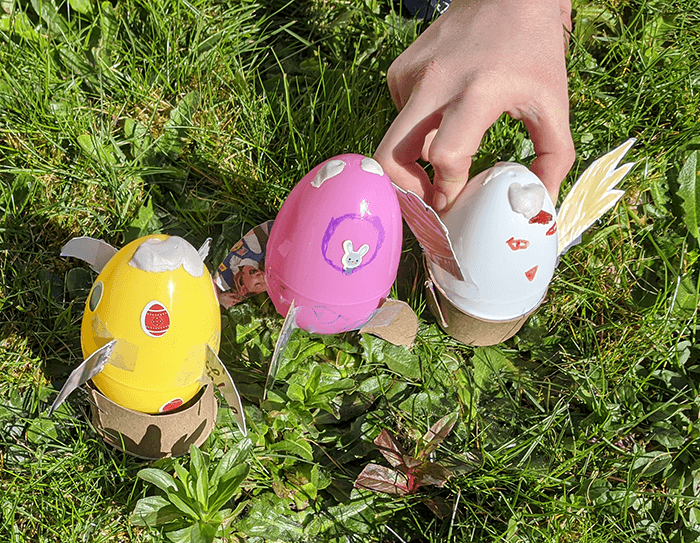
Other "Egg" Options
I listed several activities above that you might consider at this time of year, but there are lots of other options! If you happen to have a Ping Pong Catapult at home, launching plastic eggs with it can be a lot of fun. Or make a mini catapult from craft sticks or recycled materials and use it with your plastic eggs. See Egg Science Projects for K-12 Students for even more egg-based science activities, and don't miss our fun collection of 5 STEM Activities with Marshmallow Peeps! You might also find good suggestions for your kids in the 5 Fizzing, Foaming, and Bubbling Science Projects! roundup.
If you and your kids try launching plastic Easter eggs or doing any other Spring- or Easter-themed STEM activities, post a picture of it on social media and tag us. You can find us on Twitter, Facebook, and Instagram.
If this blog post was useful to you, please share it with other parents. Follow the links below to see what other science adventures we've been having at home.
View All Posts in this Series
- Activity 1 - Getting Started and Hand Washing
- Activity 2 - Taking Flight with Kites
- Activity 3 - Candle Seesaw and Fire Science
- Activity 4 - Dissecting Flowers
- Activity 5 - Building a Toy Parachute
- Activity 6 - Paper Marbling
- Activity 7 - Shaping Hard-boiled Eggs
- Activity 8 - Invisible Ink
- Activity 9 - Robot Hand
- Activity 10 - Plastic Egg Rockets
- Activity 11 - Rubber Band Guitar
- Activity 12 - Making Model Viruses
- Activity 13 - Air Cannons
- Activity 14 - Balancing an Art Mobile
- Activity 15 - Gumdrop Geometry
- Activity 16 - Solar Updraft Tower
- Activity 17 - Cotton Ball Launcher
- Activity 18 - Wire Water Striders
- Activity 19 - Ice Cream in a Bag
- Activity 20 - Wind-powered Sail Cars
- Activity 21 - Curling Metal
- Activity 22 - Popsicle Stick Catapult
- Activity 23 - Candy Diffusion
- Activity 24 - STEM Videos
- Activity 25 - Making Slime
- Activity 26 - Straw Siphon
- Activity 27 - Elephant Toothpaste
- Activity 28 - Balloon Hovercraft
- Activity 29 - Aluminum Foil Boats
- Activity 30 - Wall Marble Run
A science activity log is available as a Word document or as a Google doc for online convenience. (Just choose "File/Make a copy" to save it to your Google Drive.)
About the Author
Sandra, Science Buddies' Vice President of STEM education, holds a PhD in Genetics from Stanford University and has spent the last twelve years working on science education and STEM outreach. Right now, she's stuck working from her home in the Pacific Northwest with her husband, second grader, middle schooler, and two oddly noisy gerbils. She hypothesizes her sanity will hold as long as she gets a daily dose of sunshine.
Categories:
You Might Also Enjoy These Related Posts:
- Wall Marble Run: Doing Fun Science at Home during School Closures (Activity #30)
- Aluminum Foil Boats: Doing Fun Science at Home during School Closures (Activity #29)
- Hovercraft: Doing Fun Science at Home during School Closures (Activity #28)
- Elephant Toothpaste: Doing Fun Science at Home during School Closures (Activity #27)
- Straw Siphon: Doing Fun Science at Home during School Closures (Activity #26)
- Slime Three Ways: Doing Fun Science at Home during School Closures (Activity #25)
- A STEM Videos Breather: Doing Fun Science at Home during School Closures (Activity #24)
- Candy Experiments: Doing Fun Science at Home during School Closures (Activity #23)










